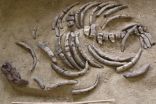(Press-News.org) Sirenians, or sea cows, are a particular group of mammals that superficially resembles whales in having, amongst other features, a streamlined-body and horizontal tail fluke. Though belonging to the so-called marine mammals, such as whales and seals, sea cows are members of a group having a single origin that includes their closest living relatives, the proboscideans (or elephants in the broader sense).
Today, sirenians are known by only four species, but their fossil record is much more diverse documenting the transition from land-dwelling animals to fully aquatic ones. This makes fossil representatives of this group not only very fascinating, but also crucial for the understanding of the transition from life on land to the sea and the past diversity of the order Sirenia.
Considering the oldest known member of this order, Prorastomus from the Eocene (~50 Ma – Millions of years before present) of Jamaica, first fully aquatic sea cows already occurred by approximately 42 Ma, which indicates a relatively fast transitional process. Later forms still retained a small femur, which however was no more visible outside. Amongst such sirenians, one species was distributed in a shallow marine area, now occupied by Germany and Belgium, about 30 Millions of years ago in the early Oligocene. This respective species was hitherto known as Halitherium schinzii and believed to represent the only sea cow that evolved in that region to that time.
In a recent publication of the open access journal Zoosystematics and Evolution, Manja Voss from the Museum für Naturkunde Berlin deals with a contrasting hypothesis of two distinct species in the early Oligocene of Central Europe. Considering the always incomplete fossil record, palaeontologists face the challenge to determine species on a material basis being as informative as possible. In the present study Manja Voss provides arguments why this is not the case with the so-called holotype, a single tooth, of H. schinzii and explains why this species name is not applicable to any currently known sirenian.
Additionally, Manja Voss emphasises that consequences are to be drawn including a morphological re-assessment of skeletal material originally assigned to this species and the requirement of new generic names for all species formerly grouped under Halitherium. Moreover, it is acknowledged that this genus does not only include unrelated species, but is also the name giving basis for a subfamily, the Halitheriinae, that is likewise far from forming a single entity. Therefore, the proposed rejection of these specific termini shall help to better handle the known diversity of the sirenian order.
INFORMATION:
Original Source:
Voss M (2014) On the invalidity of Halitherium schinzii Kaup, 1838 (Mammalia, Sirenia), with comments on systematic consequences. Zoosystematics and Evolution 90(1): 87-93. DOI: 10.3897/zse.90.7421
Killing a name of an extinct sea cow species
2014-04-02
ELSE PRESS RELEASES FROM THIS DATE:
Ethics guidelines for next generation of risky NASA missions
2014-04-02
MEDIA ADVISORY: Institute of Medicine Committee to Report on Ethical Guidelines For Health Standards on Next Generation of NASA Missions: Long Duration and Exploration Spaceflights
WHEN: Embargoed until Wednesday April 2, 2014 11:00 AM EDT
WHAT: Spaceflights beyond low earth orbit or lasting longer than 30 days, including extended stays on the International Space Station and missions to Mars, will likely expose astronauts to increased and even unknown levels of risk, and therefore would not meet NASA's current health standards. The space agency commissioned a report ...
Intelligent warning systems may make 'dilemma zone' safer
2014-04-02
Most drivers have experienced a traffic signal that turns yellow just as they approach an intersection, which makes it difficult for them to decide whether to stop or proceed through it. The wrong choice in this critical situation, known as the "dilemma zone," may lead to crashes, especially at high-speed intersections. A new study published in Human Factors examines how intelligent warning systems help drivers negotiate the dilemma zone and encourage safer driving behavior.
"Intelligent systems could improve driver safety by potentially reducing crashes at signalized ...
Longer stay in hospital ICU has lasting impact on quality of life
2014-04-02
Patients have substantial physical impairments even two years after being discharged from the hospital after a stay in an intensive care unit (ICU), new Johns Hopkins research suggests.
The scientists found that for every day of bed rest in the ICU, muscle strength was between 3 and 11 percent lower over the following months and years.
"Even a single day of bed rest in the ICU has a lasting impact on weakness, which impacts patients' physical functioning and quality of life," says Dale M. Needham, M.D., Ph.D., an associate professor of medicine and of physical medicine ...
Drexel researchers open path to finding rare, polarized metals
2014-04-02
VIDEO:
Researchers in Drexel's College of Engineering have discovered a way to classify and predict the existence of a rare breed of electrically conductive polar metals.
Click here for more information.
PHILADELPHIA - Drexel University researchers are turning some of the basic tenets of chemistry and physics upside down to cut a trail toward the discovery of a new set of materials. They're called "polar metals" and, according to many of the scientific principles that govern the ...
A rainy day can ruin an online restaurant review
2014-04-02
After looking at 1.1 million online reviews for 840,000 restaurants in more than 32,000 cities across the country, Georgia Tech and Yahoo Labs researchers have found that the weather outside can be just as significant a factor for reviews as what happens inside a restaurant. Their study shows evaluations written on rainy or snowy days, or very cold or hot days, are more negative than those written on nice days.
"People love to describe themselves as foodies. But in the end, it looks like we're all weather people, whether we realize it or not," said Saeideh Bakhshi, a ...
Pharmocogenomics has not fulfilled its promise to developing countries
2014-04-02
From 1997 to 2010, despite promises made by the international scientific community, pharmacogenomic research produced few studies focusing on rare, orphan and tropical diseases prevalent in developing countries. Catherine Olivier, bioethics research at the University of Montreal's School of Public Health, recently published these findings in the journal Global Public Health.
Pharmcogenomics is a field of scientific research that studies the interaction between the genomic information of individuals (or populations) and their responses to drugs. In addition to its promising ...
The science of champagne fizz: How many bubbles are in your bubbly?
2014-04-02
The importance of fizz, more technically known as effervescence, in sparkling wines and champagnes is not to be underestimated — it contributes to the complete sensory experience of a glass, or flute, of fine bubbly. A scientist has now closely examined the factors that affect these bubbles, and he has come up with an estimate of just how many are in each glass. The report appears in ACS' The Journal of Physical Chemistry B.
Gérard Liger-Belair notes that effervescence plays an important role in the look, taste, aroma and mouth feel of champagne and other sparkling wines. ...
Albertans support perinatal mental health screening
2014-04-02
After struggling with anxiety and depression since her teens, Lana Berry hit bottom at age 26. Divorced, unemployed and back living with her parents, she found herself in a dark place—"as sick as I'd ever been."
Berry persevered, pouring her energy into getting better. She found work, met the love of her life, remarried and, six years after her low point, found out she was going to be a mom. Given her past, she was understandably anxious about what to expect.
"I did have worries, but I didn't have regular conversations with doctors about depression. They would only ...
Radiation able to be securely stored in nontoxic molecule, study finds
2014-04-02
MANHATTAN, Kan. — Researchers have discovered that microscopic "bubbles" developed at Kansas State University are safe and effective storage lockers for harmful isotopes that emit ionizing radiation for treating tumors.
The findings can benefit patient health and advance radiation therapy used to treat cancer and other diseases, said John M. Tomich, a professor of biochemistry and molecular biophysics who is affiliated with the university's Johnson Cancer Research Center.
Tomich conducted the study with Ekaterina Dadachova, a radiochemistry specialist at Albert Einstein ...
From Martian rocks, a planet's watery story emerges
2014-04-02
After 18 months on Mars, the rover Curiosity has taken more than 120,000 measurements of surface rocks and soil, painting a more detailed image of how much water was once on the Red Planet. An article in Chemical & Engineering News (C&EN) describes the technique scientists are using to analyze the rocks and what they've found.
Celia Arnaud, a senior editor at C&EN, notes that Curiosity has traveled nearly 4 miles since it landed in 2012 and is more than halfway to its destination, Mount Sharp. But in the meantime, its onboard equipment is collecting a treasure trove of ...



